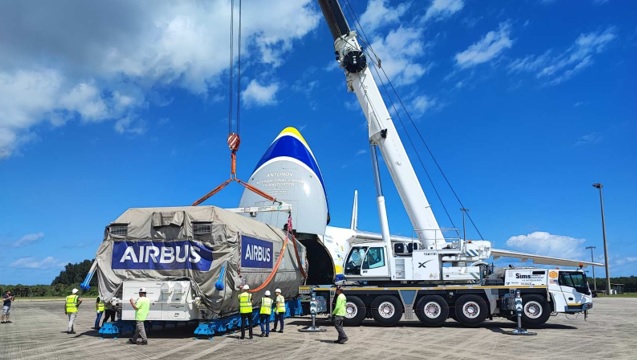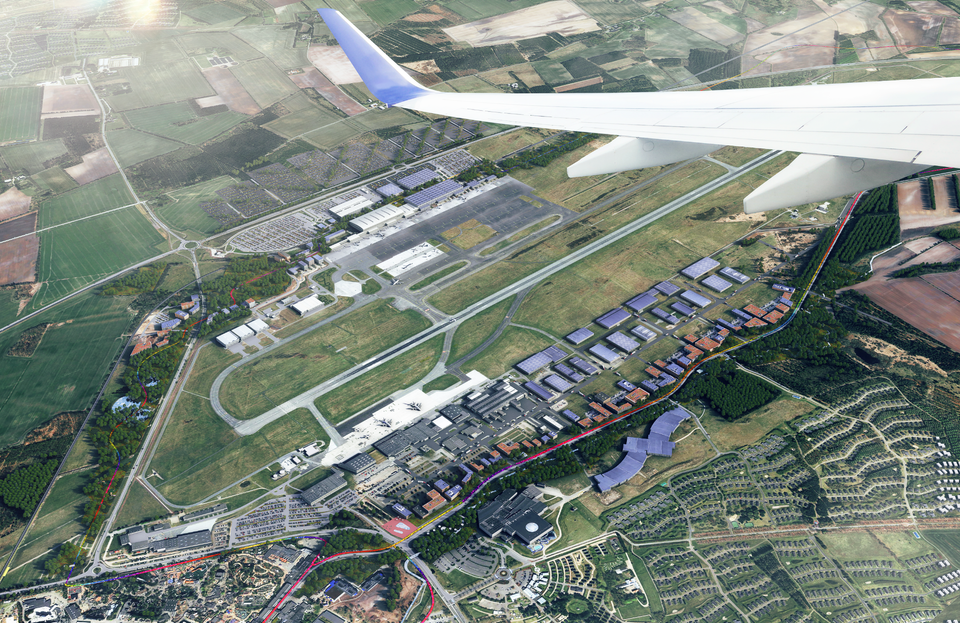Heavylift sector faces up to an uncertain market
06 / 01 / 2023

Airbus satellite transport. Photo: Antonov Airlines
The heavylift sector is facing up to challenging market conditions but there are some positives to be found, writes Michael Mackey.
Heavylift air cargo faces a difficult future despite an obvious need for its services.
“I would describe the current situation as a ‘tough market’,” Reto Hunziker, regional director Europe for Chapman Freeborn tells Air Cargo News.
Several factors besides a generally tightening economic situation explain why.
There is limited demand for airfreight, adds Hunziker, although there is a debate about this.
Seafreight taking back market share from airfreight again post Covid-19 is another pressure point.
Agreement for this, although with a slightly different emphasis, comes from The Heavy Lift Group (THLG).
THLG’s president and business development officer Murilo Caldana sums up the market: “Inflation, less consumption, more space availability on vessels, more space available on airplanes.
“Prices [are] going down and depending on type of cargo, size, weight and added value, airfreight makes sense.”
Another challenge is on the side of the suppliers, with less capacity in terms of the largest aircraft that can carry heavylift cargo.
Here geopolitical events intrude. There is, as Hunziker points out “the lack of access to Russian carriers and a shortage of Ukrainian carriers – aircraft availabilities are limited and prices are high.”
Ukranian carriers, still doggedly in the market, have their own take on this.
Mainly, medical cargo was transported, and project transportations occupied a small share with automotive and manufacturing industries increasing, that was till Russia’s tanks rolled, an Antonov official tells Air Cargo News.
“Since the end of March, the number of requests for the transportation of project cargo has increased rapidly, and the request for the transportation of cargo for the aviation and aerospace industry has also increased,” the official says.
Not only is there an operational impact but an economic one too.
“The invasion of Russia on the territory of independent Ukraine and the introduction of sanctions against the aggressor led to a rise in fuel prices and an increase in transportation tariffs, which were also affected by the Omicron pandemic in China and world inflation, all of this became important factors for changes on the market for transportation of oversized and super-heavy cargo,” the official adds.
At this stage, no one is expecting the situation to get better anytime soon and the war is only one factor.
“The next five years will probably continue to be unpredictable and challenging; we are facing market fatigue, exhausted budgets and economic instability in a post-Covid-19 world, exacerbated by the war in Ukraine,” says Hunziker. “Furthermore, companies are cautious about making big investments.”
Energy logistics
That caution aside, the industry has got on with things as best it can in difficult circumstances with key drivers being the usual oil and gas industry, as well as the wider energy industry.
“Geographical hot spots will be Asia and Australia, as well as the US and Europe, especially in the oil and gas industry,” says Hunziker.

Reto Hunziker. Photo: Chapman Freeborn
“Europe is still faced with the challenging and ever-changing situation in Ukraine and Russia.
“If the conflict can be settled, there is then the potential of backlog demand in both countries. There is less of a focus on Africa, with the exception of Nigeria, in regard to the oil and gas industry.”
Offsetting some of the pessimism is a sector that is not just sat around waiting for an upswing but working towards a more productive future.
Also interesting part is the ongoing emergence of THLG. It is not really a company, more an international group of specialised heavy transport companies that combine their resources to offer the best service to customers who often have very different requirements.
Members of THLG specialize in things such as large-scale industrial project forwarding, crane operations, machinery installation and rigging, vessel chartering, port operations, oversized road transport, engineering, and aircraft charters as well as barge operations.
The group was founded in 1987 by a number of west European heavylift operators in anticipation of the Single European Market.
Since then it and the world have changed and it has developed to reflect this now having members in North & South America, Asia, the Middle East, Africa and the CIS.
Matching this geographical spread, the know-how, skills, experience and equipment of its membership mean THLG can cover any movement or transport requirement from a single domestic job to the largest international multi-modal project, said Murilo Caldana of FOX Logistics Brazil and also president of the Group.
“Our main focus is projects. So yes, we get involved on airfreight shipments mostly on charter flights moving heavy pieces like: turbines, generators, transformers, machinery, etc,” Caldana says.
Part of this, and a part of the problem the heavylift as a sector faces, is the sheer variability on what they are required or asked to do. It is also not the most regular of work.
“Our demand is not regular, but it can happen that a rotor of a hydro power plant can be damaged for some reason, and to avoid losses, we need to fly them,” Caldana adds.
Infrastructure challenges
Another problem is getting aircraft to the point of origin, which is often the end of a long and exhausting process.
Antonov did manage this in Bolivia though. Here 12 charter flights were organised because bridges from the port to the job site were damaged and not able to reliably shoulder the weight of 12 heat recovery steam generators, each weighing 160,000 kg.
The generators were flown from Iqueque in Northern Chile to Chimore across the border. A short distance as the crow flies but given the weights not doable overland.
“So transport by road was unfeasible and we had to fly them,” Caldana explains.
This shows another of the problems heavylift cargo faces – in parts of the world there is a problem with the sheer lack of infrastructure and the vexing and pervasive problem of bureaucracy.
Feasibility and experience of airports close to destination to handle heavy pieces was an example Caldana gave when asked about the barriers to future growth.
“Route permits and challenges according to each country’s legislations to move and transport cargo, to make sure it will arrive on time,” were other challenges, he says.
However, he is not a total pessimist about the sector’s future describing it as “uncertain, but also [with] opportunities”.
One facility hoping to handle more heavylift shipments is Denmark’s Billund Airport.
Part of the reason for the airport’s positive outlook is geography as the facility is the best and fastest way to Jutland, Fyn and North Germany.
Nor is it too far from Scandanavia and Germany/Benelux – prime economic positioning, especially for both the old and new energy technologies and engineering.
“Cargo Center Billund is placed strategically within reach of global companies such as shipyards, oil rigs and wind turbine manufacturers, where we have the pleasure handling some of their heavy cargo.
“For example we have shipped windmill parts, generators, engine shafts and drill pipes for oilrigs. All where we have to take special care of the weight and volume of the cargo,” Brian Sørensen, ramp supervisor, at the Cargo Center says.

Red and blue buildings show possible developments. Photo: Billund Airport
Backing this up are some impressive add-ons as it has more than 21,000 sq m of storage area, including freezing and cooling capacity.
With the ground equipment available in Billund, it is confident it can handle almost all types of aircraft and cargo and it also claims to have a network of local entrepreneurs, that are ready to assist with special equipment and trucks.
“Most special, heavy or big volume cargo requires some kind of special handling equipment, and we will be available to assist with the best solution for the customer,” says Sorensen.
Sales pitches aside Sorensen does have grounds for optimism including an interesting precedent although there is also some caution as there is elsewhere.
“We are looking into a bright future,” he says. “The future for heavylift in Billund is hard to foresee, but the global market for green energy is rising and with some of the market leaders within the windmills sector close by, we can expect more heavylift shipments in the future.”
Interestingly Billund is already looking to expand its cargo capacity and whilst the rhetoric is of being an ‘Aviation City’ the facility does not let itself be drawn on the details of its proposed freight capabilities.
The precedent though is telling. When Covid-19 became a global pandemic, Billund Airport was a significant factor in getting medical equipment from Asia to Denmark, in a fast and secure way.
“With hard work and numerous B747, AN-124 and even AN-225, we provided the medical sector with the needed medical equipment. More of these scenarios will come in the future and Billund will be ready,” says Sorensen.
Supply chain spotlight: Ukraine crisis adds to heavylift constraints













